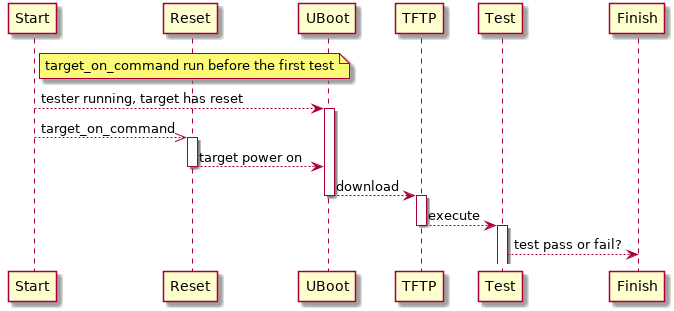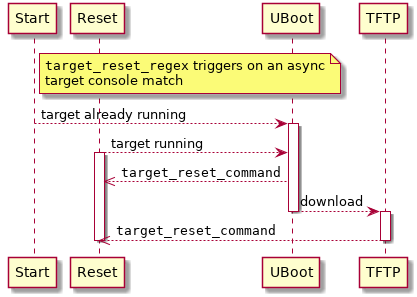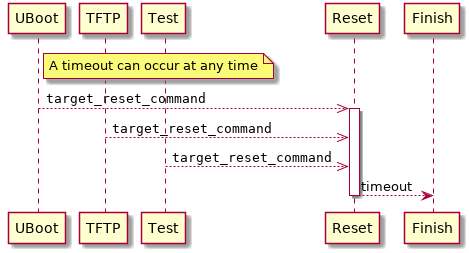11.9. TFTP and U-Boot#
TFTP and U-Boot provides a simple way to test RTEMS on a network capable target. The RTEMS Tester starts a TFTP server session for each test and the target’s boot monitor, in this case U-Boot request a file, any file, which the TFTP server supplies. U-Boot loads the executable and boots it using a standard U-Boot script.
The RTEMS Tester contains a TFTP server so no external TFTP server or configuration is required. If you have an external TFTP server and wish to use that resource the Wait directive can be used.

Fig. 11.5 RTEMS Tester using TFTP and U-Boot.#
The Figure RTEMS Tester using TFTP and U-Boot. figure shows the structure and
control flow of the RTEMS Tester using TFTP and U-boot. The executables are
built and the rtems-test command is run from the top of the build
directory.
This test mode can only support a single test job running at once. You cannot add more test target hardware and run the tests in parallel.
11.9.1. Target Hardware#
The RTEMS Tester TFTP and U-Boot method of testing requires:
A target with network interface.
U-Boot, iPXE or similar boot loader with network driver support for your target hardware and support for the TFTP protocol.
Network power of IO switch.
Network DHCP server.
Console interface cable that matches your target’s console UART interface.
Telnet terminal server. See Consoles.
The network power or IO switch is a device that can control power or an IO pin over a network connection using a script-able protocol such as Telnet or curl. This device can be used with the target control commands.
11.9.1.1. U-Boot Set Up#
Obtain a working image of the U-Boot boot loader for your target. We suggest you follow the instructions for you target.
Configure U-Boot to network boot using the TFTP protocol. This is U-Boot script for a Zedboard:
loadaddr=0x02000000
uenvcmd=echo Booting RTEMS Zed from net; set autoload no; dhcp; set serverip 10.10.5.2; tftpboot zed/rtems.img; bootm; reset;
The load address variable loadaddr is specific to the Zedboard and can be
found in the various examples scripts on the internet. The script then sets
U-Boot environment variable autoload to no causing DHCP to only request
a DHCP lease from the DHCP server. The script sets the serverip to the host
that will be running the RTEMS Tester then issues a TFTP request. The file name
can be anything because the RTEMS Tester ignores it sending the executable
image under test. Finally the script boots the download executable and if that
fails the catch all reset resets the board and starts the boot process
over.
Test the target boots and U-Boot runs and obtains a valid DHCP lease. Manually connect the console’s telnet port.
11.9.2. BSP Configuration#
The BSP’s configuration file must contain the standard fields:
bsparchjobs- Must be set to1.tester- Set to%{_rtscripts}/tftp.cfg
For example the Zedboard’s configuration is:
[xilinx_zynq_zedboard]
bsp = xilinx_zynq_zedboard
arch = arm
jobs = 1
tester = %{_rtscripts}/tftp.cfg
The TFTP configuration supports the following field’s:
bsp_tty_devThe target’s tty console. For telnet this is a host and port pair written in the standard networking format, for example
serserver:12345.test_restartsThe number of restarts before the test is considered
invalid.target_reset_regexThe target reset regular expression. This is a Python regular expression used to filter the console input. If a match is made something has happened during the boot process that requires a reset. The
target_reset_commandis issued to perform the reset. This field is typically looks for boot loader error messages that indicate the boot process as failed.target_start_regexThe target start regular expression. This also a Python regular expression to filter the console input to detect if a target has reset. If a board crashes running a test or at any point in time and reset this filter detects this as happened and end the test with a suitable result.
target_on_commandThe target on command is a host shell command that is called before the first test. This command powers on a target. Targets should be left powered off when not running tests or the target may request TFTP downloads that are for another target interfering with those test results. We recommend you implement this command as a target off command, a pause, then a target on command.
target_off_commandThe target off command is a host shell command that is called after the last test powering off the target.
target_reset_commandThe target reset command is a host shell command that is called when the target needs to be reset. This command can power cycle the target or toggle a reset signal connected to the target. If you are power cycling a target make sure you have a suitable pause to let the target completely power down.
target_pretest_commandThe target pretest command is a host shell comment that is called before the test is run
The commands in the listed fields can include parameters that are substituted. The parameters are:
@ARCH@The BSP architecture
@BSP@The BSP’s name
@EXE@The executable name.
@FEXE@The
- . The
@ARCHis the
substituted
Some of these field are normally provided by a user’s configuration. To do this use:
requires = bsp_tty_dev, target_on_command, target_off_command, target_reset_command
The requires value requires the user provide these settings in their
configuration file.
The Zedboard’s configuration file is:
[xilinx_zynq_zedboard]
bsp = xilinx_zynq_zedboard
arch = arm
jobs = 1
tester = %{_rtscripts}/tftp.cfg
test_restarts = 3
target_reset_regex = ^No ethernet found.*|^BOOTP broadcast 6.*|^.+complete\.+ TIMEOUT.*
target_start_regex = ^U-Boot SPL .*
requires = target_on_command, target_off_command, target_reset_command, bsp_tty_dev
The target_start_regex searches for U-Boot’s first console message. This
indicate the board can restarted.
The target_reset_regex checks if no ethernet interface is found. This can
happen if U-Boot cannot detect the PHY device. It also checks if too many DHCP
requests happen and finally a check is made for any timeouts reported by
U-Boot.
An example of a user configuration for the Zedboard is:
[xilinx_zynq_zedboard]
bsp_tty_dev = selserver:12345
target_pretest_command = zynq-mkimg @EXE@
target_exe_filter = /\.exe/.exe.img/
target_on_command = power-ctl toggle-on 1 4
target_off_command = power-ctl off 1
target_reset_command = power-ctl toggle-on 1 3
11.9.3. TFTP Sequences#
Running a large number of tests on real hardware exposes a range of issues and RTEMS Tester is designed to be tolerant of failures in booting or loading that can happen, for example a hardware design. These sequence diagrams document some of the sequences that can occur when errors happen.
The simplest sequence is running a test. The target is powered on, the test is loaded and executed and a pass or fail is determined:

Fig. 11.6 Test Pass and Fail Sequences#
The target start filter triggers if a start condition is detected. This can happen if the board crashes or resets with no output. If this happens repeatedly the test result is invalid:

Fig. 11.7 Target Start Filter Trigger#
The reset filter triggers if an error condition is found such as the bootloader
not being able to load the test executable. If the filter triggers the
target_reset_command is run:

Fig. 11.8 Target Reset Filter Trigger#
If the RTEMS Tester does not detect a test has started it can restart the test by resetting the target. The reset command can toggle an IO pin connected to reset, request a JTAG pod issue a reset or turn the power off and on:

Fig. 11.9 Target Timeout#
